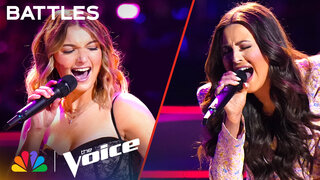Create a free profile to get unlimited access to exclusive show news, updates, and more!
Runs? Riffs? Falsetto? The Meanings Behind Musical Terms Heard on The Voice
The Coaches on The Voice toss a lot of musical lingo around as they help contestants hone in on their musical technique.
Ever wonder what the Coaches are talking about when using specific musical terms on The Voice? Well, wonder no more because here is your go-to guide to understanding some words commonly used within the music industry.
Coaches Blake Shelton, Kelly Clarkson, Niall Horan, and Chance the Rapper continue to impart their wisdom to aspiring superstars wishing to share their talent with the world on Season 23 of the show. Each Coach works with their team members (hand-picked during the show’s Blind Auditions) one-on-one in the studio and on stage, trying to help them make their vocal technique pitch perfect.
Here is a run-down of some of those terms and their descriptions.
1. What Are Runs?

Clarkson recently complimented contestant Holly Brand for her “amazing runs” during the show’s Battle Rounds, but you’re not alone in wondering what they are.
Runs are consecutive notes (typically three or more) sung in rapid succession as part of a scale, moving either up or down or back and forth from a base note or a musical syllable (think of it like the cool big sister of a melisma). Runs are controlled musical sequences that feel like straying from a tune but, when executed properly, help enhance the music.
RELATED: This Legendary Voice Coach Just Announced a Vegas Residency—How You Can Get Tickets
They are especially common in the R&B and gospel genres, as seen here in “Five R&B Vocal Runs You Need To Hear” by O’Neil Gerald’s Reclaim Your Voice Masterclass, featuring a breakdown of some of the genre’s most impressive runs. Many artists, including Christina Aguilera, Mariah Carey, and Whitney Houston, have come to perfect the technique.
2. What Is a Falsetto?

An “airy falsetto” might have earned Ryley Tate a Playoff Pass on The Voice. Here is a breakdown of what that means.
According to the encyclopedia, falsetto is “the upper register of the human voice, the opposite of chest voice.” Unlike a “head voice,” which isn’t as breathy and light as falsetto, falsetto is applied by “loosening” the vocal cords when aiming for the high notes, popular in artists such as The Bee Gees and, more modernly, The Weeknd.
The Ramsey Voice Studio illustrates the differences between head voice and falsetto here.
3. What Are Riffs?
Closely related to runs, riffs also complement a song but are more subtle than their running big brother. Riffs aren’t meant to draw as much attention to a singer’s technique as runs are intended and feel a little sneakier and neatly folded into the song.
Of course, to the untrained ear, runs and riffs sound like they could be the same thing, but they are not, as well-known vocal coach Paul McKay shows here in his rendition of "The Star-Spangled Banner."
“A riff you’ll find within a phrase or within a word, or syllables with words, as a compliment or an accent to that word or phrase,” said McKay. “While a run is typically longer and generally featured.”
You can hear many riffs in Ed Sheeran’s “Thinking Out Loud” or Sam Smith’s “Lay Me Down.”
4. What Does Texture Mean in Music?

Cait Martin impressed The Voice Coaches with her texture, which is how varying melodies and harmonies interact with one another to form a cohesive sound. Textures contain four categories: monophony, polyphony, homophony, and heterophony.
The Singer’s Heart music blog says, like fabric, vocal textures (in their broadest sense) can be cool and smooth, as opposed to grainy or rough. Several aspects are considered to hear a singer’s texture, including the song’s genre, the shaping of consonants and vowels, and relaxation.
Online singing coach Dr. Dan provides a range of textures in this how-to video of him singing “Happy Birthday,” discussing the importance of breath management.
Textures are commonly mistaken for nuances in tone (a term you’ll also often hear on The Voice), which refers to quality and frequency. Timbre, on the other hand, refers to distinction, according to Musical U (think of how different it might sound if Coaches Blake Shelton and Kelly Clarkson sang the same A sharp).
5. What Is Vibrato?
The Voice’s Season 23 showed us some of the performers’ “intoxicating vibrato,” and you can probably guess what that means just by looking at the word. It is when musical notes vibrate with subtle pulsations or wavering commonly heard at the tail-ends of longer notes.
Coaches referred to contestant Cait Martin’s “beautiful vibrato” when all four turned their chairs to face her performance.

Vibrato varies with speed between singers (one can easily note Coach Shelton’s wife, Gwen Stefani, when she uses her trademark, unique vibrato in song).
Historically, vibrato was used as a means for opera singers performing live, when tasked with projecting their voices to live audiences, per BBC Music magazine. The flutter-esque technique is hardly noticed when executed over live orchestras in concert halls.
The technique has lived on for centuries.
6. Chest voice
The opposite of the aforementioned head voice (and its little Italian cousin, falsetto) is a chest voice. As you guessed, it is a powerful style of singing that comes from the chest, which could help avoid straining the vocal cords, according to the Atlanta Institute of Music and Media.
“Chest voice refers to [those] lower, thicker, and warmer tones,” according to the school. “It also reflects the register that we normally use speaking.”
When using the chest voice, singers will feel the vibrations from their torso, as opposed to a head voice, which is tinnier. The Spencer Welch Music Studio refers to a head voice as having a “light, more flute-like” quality (working best in a singer’s upper range), while a chest voice has a heavier, thicker, and brassier quality, as seen here.
7. What is the Yodel?
Yodeling is not just reserved for men in lederhosen but is a difficult technical device used across a number of music genres. Hank Williams perfected it with his classic country music, such as with his song “I'd Still Want You.” The late Irish legend Dolores O’Riordan of The Cranberries regularly used the technique during much of her career, such as in the song “Dreams” (not to be confused with the sound of Irish keening, which the “Zombie” singer also popularized).
By definition, yodeling is the rapid back and forth between the normal singing voice and falsetto, or a switch between the aforementioned head voices and chest voices.
If you listen closely, you can hear a 13-year-old Coach Shelton use the technique here. But let us not ever forget the video of the “Walmart Yodeling Kid” that went viral a few years back (singing none other than Hank Williams’ “Lovesick Blues”), which makes for the perfect example of yodeling perfection.
You can see and hear more musical techniques on The Voice, airing Mondays at 8/7c on NBC and the next day on Peacock.







